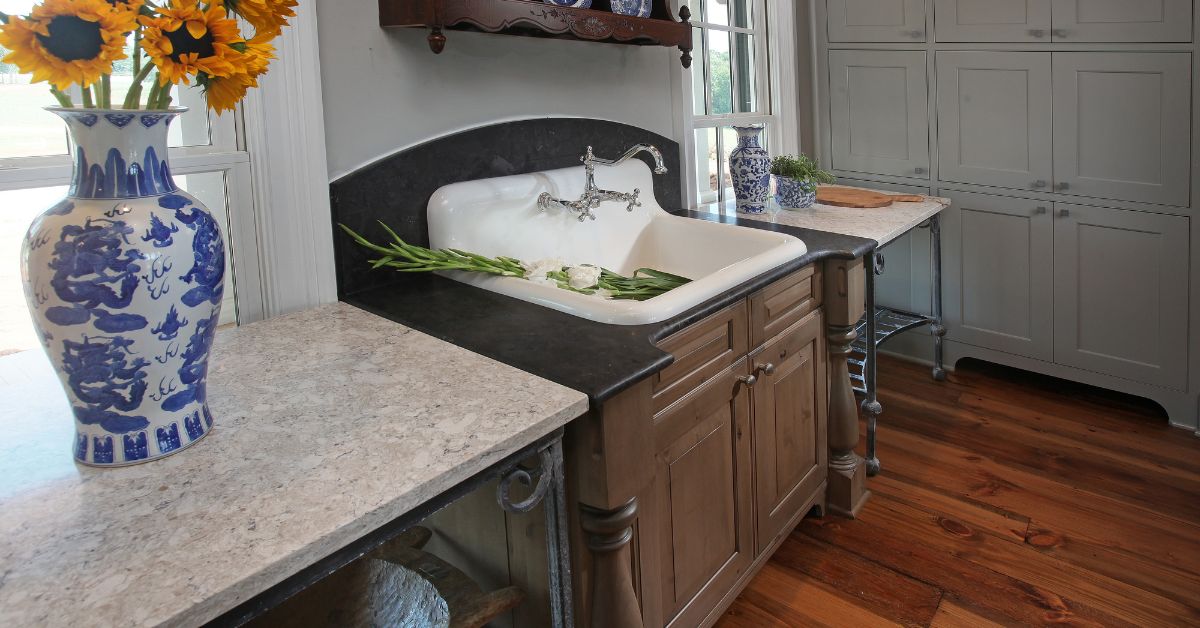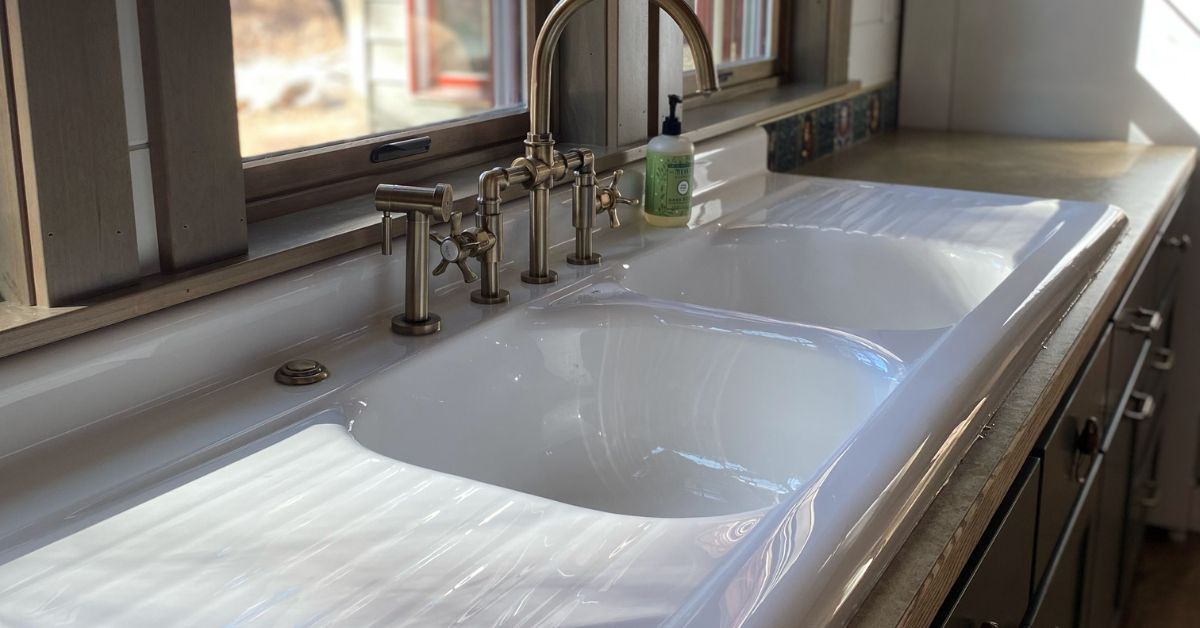
When you take a moment to think about a kitchen sink, you might come to the conclusion that it’s essential to daily life. For centuries, it has served as a functional centerpiece of kitchens, adapting and evolving alongside human needs and technological advances. From rudimentary basins to contemporary masterpieces, kitchen sinks tell a story of innovation, craftsmanship, and changing lifestyles. This deep dive into the fascinating history and evolution of kitchen sinks reveals the practical developments of sinks and their reflection of society’s progression.
The Earliest Basins
Ancient civilizations relied on simple stone basins to collect and transport water. These early “sinks” were rudimentary, lacking any form of drainage or plumbing systems. Instead, people used manual effort to fetch water from natural sources and empty waste water elsewhere. Individuals had to conduct this challenging, labor-intensive activity for numerous household tasks. Therefore, the earliest basins were valuable yet inefficient.
Advancements With Clay and Ceramic Sinks
Over time, societies, such as the Romans, advanced the design of basins by crafting them from clay and ceramic materials. These innovations not only made basins more durable but also allowed for artistic expression through decorative patterns and designs. Blending practicality with aesthetics marked a shift in how people viewed household tools because basins became an integral part of home decor without losing their functional purpose.
Wooden Sinks in Medieval Kitchens
During the medieval period, wooden sinks became a common feature in kitchens, carved from large planks of wood. The basins required people to manually pour the water, as plumbing systems weren’t around yet.
However, the porous material demanded constant maintenance to prevent rot and contamination. Despite their limitations, wooden sinks served their purpose in an era with limited resources, representing a practical yet imperfect solution.

Stone Sinks for Wealth and Prestige
The introduction of heavy stone sinks marked a substantial leap in practical use and status. These durable designs were typically reserved for wealthier households, where they became a symbol of permanence and prosperity. Stone sinks were not just practical but also stood as a statement piece, reflecting the affluence and taste of their owners. Their weight and durability made them a long-term investment, further reinforcing their role as a sign of prestige.
The Introduction of Plumbing Systems
With the spread of plumbing systems in the 17th and 18th centuries, kitchen sinks underwent a dramatic transformation. Running water allowed for more convenient washing and eliminated the need to manually carry water in and out. This development paved the way for more efficient kitchen designs, setting the stage for sinks to become a truly integral part of modern homes.
Cast Iron and Enamel Sinks
The Industrial Revolution brought about significant advancements in sink design with the introduction of cast iron sinks coated with enamel. These sinks were durable, easy to clean, and well-suited for the needs of growing urban populations.
Mass production made them more accessible. Additionally, the glossy enamel finish added a modern touch to kitchens for a clean, polished aesthetic.
The Rise of Butler’s Sinks
In the 19th century, the butler’s sink rose to prominence, beloved for its deep, spacious design. Perfect for large households, these sinks offered plenty of room for washing dishes, food preparation, and other kitchen tasks. Their practicality made them a staple in many homes, particularly those with busy kitchens that required durability and functionality.
Modern Plumbing Integration
The 20th century brought widespread standardization of plumbing systems, and kitchen sinks became fully integrated into countertops. This change resulted in seamless, cohesive designs that allowed kitchens to become more efficient and visually appealing. The integration of plumbing also made cleaning and maintenance easier.
Stainless Steel Emerges
Stainless-steel sinks quickly gained popularity due to their durability, heat resistance, and sleek, modern appearance. Their minimalist design made them versatile enough to complement a wide range of kitchen styles. Homeowners appreciated their practicality, as they were easy to maintain and could handle the wear and tear of daily use without losing their polished look.
A Shift to Functionality
By the mid-20th century, kitchen sinks began evolving to address specific household needs. For example, dual-basin sinks became increasingly common, allowing for separate spaces to handle different cleaning tasks, such as washing dishes in one basin and rinsing in the other. This shift catered to the growing demands of modern households.
Contemporary Materials Take Center Stage
The arrival of materials like composite granite and quartz introduced a new era of kitchen sink design. These materials offered a balance of durability and aesthetic appeal, giving homeowners more options to personalize their kitchens. Sinks made from these materials stood up to daily wear and added sophisticated style to the space.

Minimalist Trends in the 21st Century
Modern kitchen design has embraced minimalism, favoring clean lines and uncluttered surfaces. Undermount sinks, for example, create a seamless transition between the countertop and the sink, making cleaning easier and enhancing the overall appearance of the kitchen. This trend reflects a desire for kitchens to feel open, streamlined, and practical.
The Return of Farmhouse Aesthetics
Farmhouse sinks, reminiscent of the classic butler’s sink, have seen a resurgence in popularity in recent decades. Their oversized basins and vintage charm appeal to homeowners looking to add a touch of traditional craftsmanship to their kitchens. These sinks combine practicality with nostalgic design, making them a favorite choice in both rustic and modern farmhouse-style kitchens.
Smart Sinks and Future Innovations
Today, innovations like touchless faucets and smart technology are pushing kitchen sinks into the future. These advancements focus on improving hygiene and efficiency, such as reducing cross-contamination and conserving water. As technology continues to evolve, the kitchen sink remains an essential but ever-adapting feature of modern living, blending practicality with cutting-edge innovation.
When you trace the history and evolution of kitchen sinks, you uncover more than just a tale of utility. This enduring household staple reflects centuries of craftsmanship, design trends, and technological breakthroughs. Whether you’re washing dishes in a classic farmhouse sink or rinsing fresh produce in a minimalist undermount sink, you connect with a tradition that spans countless generations.
Next time, as you stand at your sink, take a moment to appreciate its storied history and the pivotal role it’s played in shaping the kitchen as we know it. If you really want to appreciate how far sink technology has come, consider integrating a drop-in kitchen sink with a drainboard in your home, courtesy of your friends at NBI Drainboard Sinks! With our help, you can transform your space, functionally and aesthetically, while reaping the benefits of the kitchen sink developments that occurred over time.
